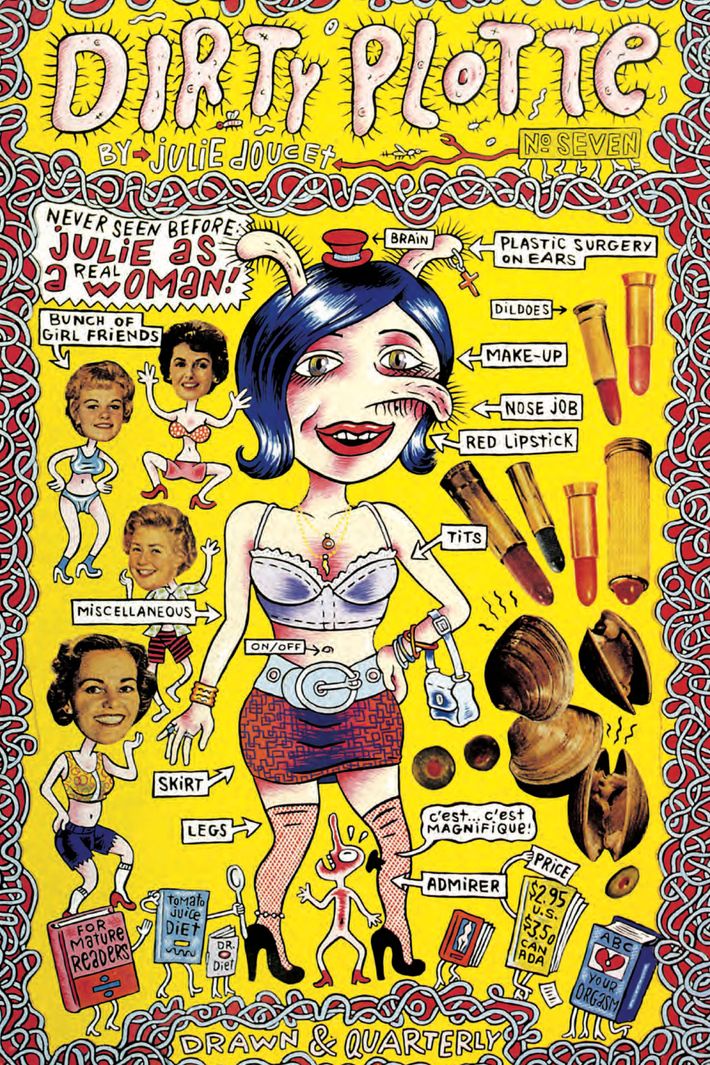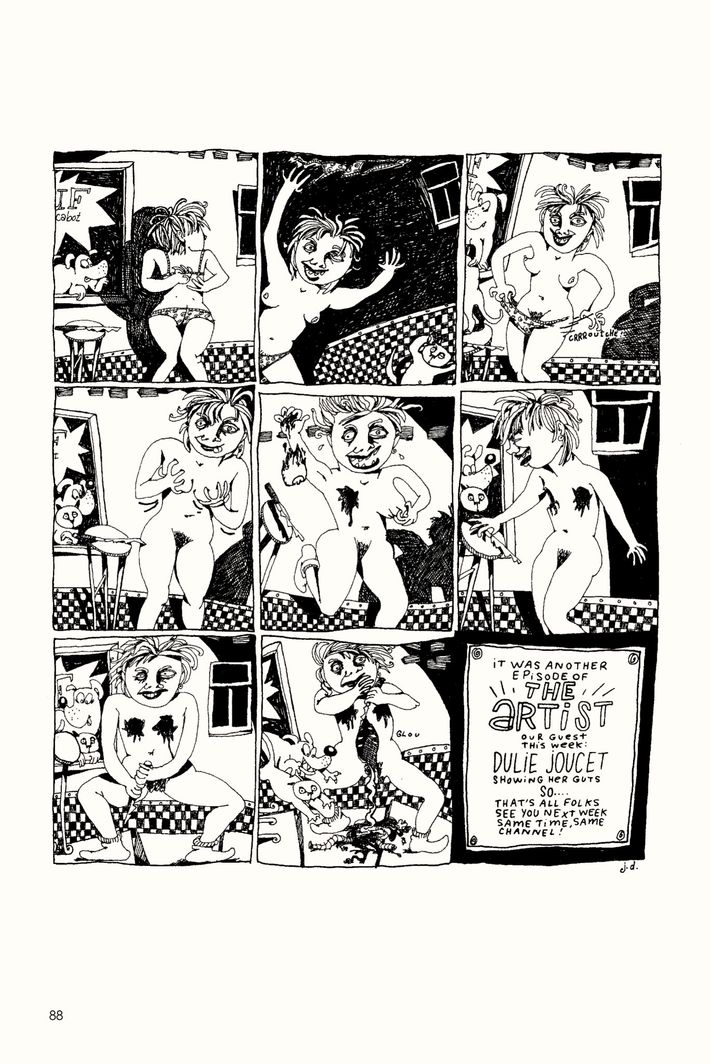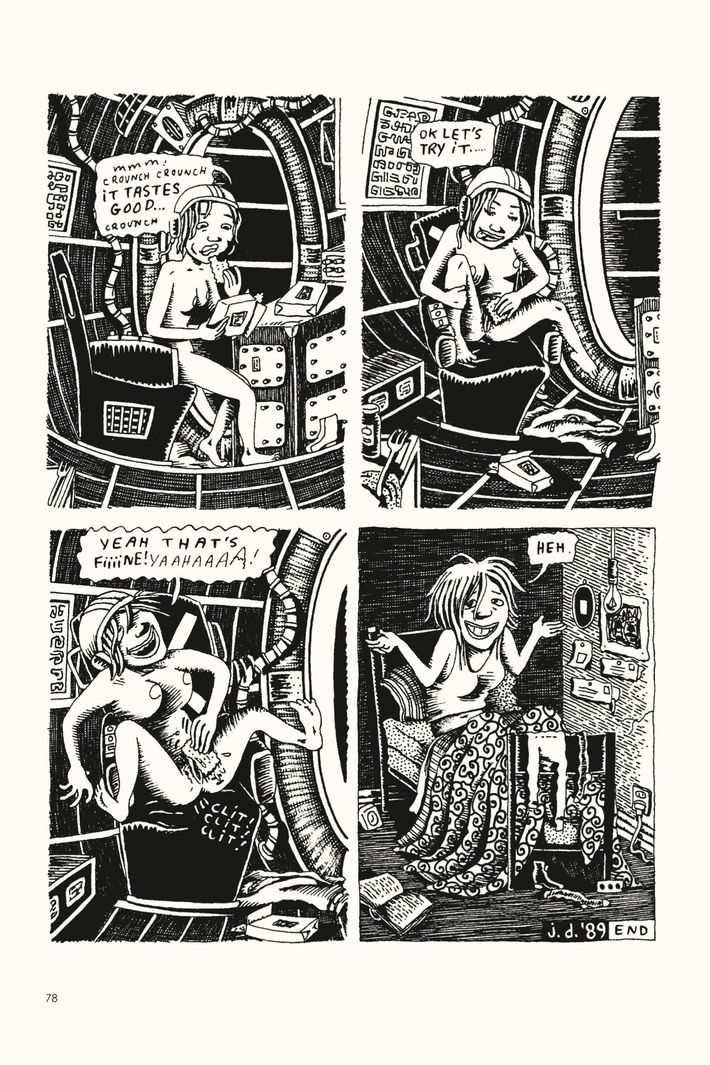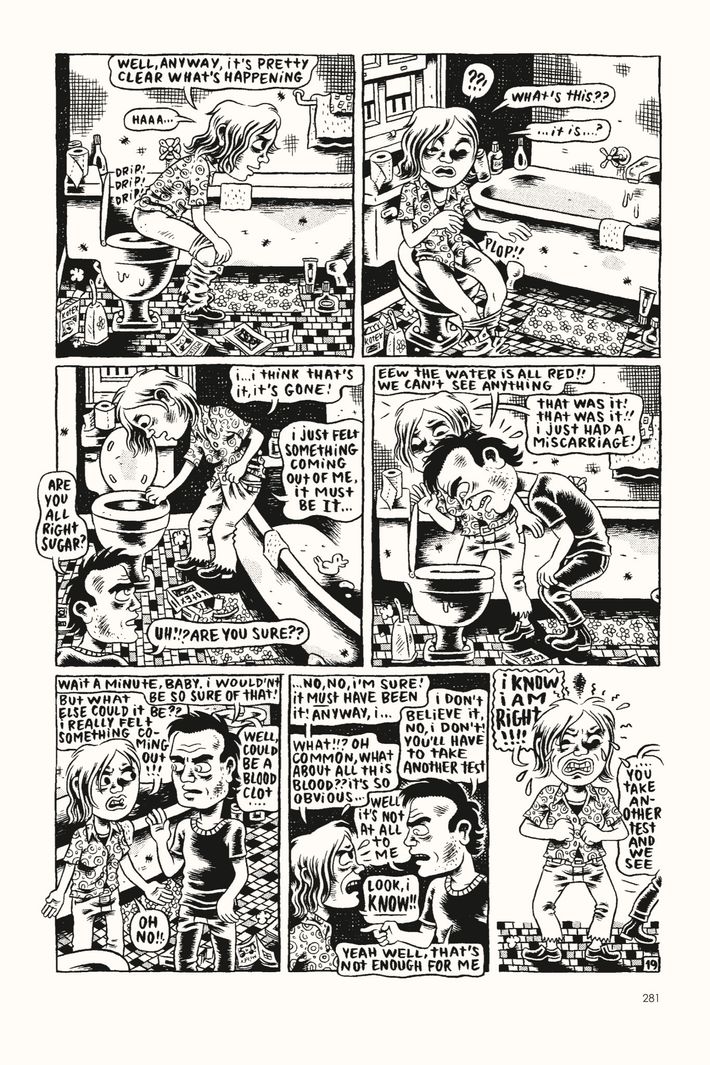
This article contains explicit illustrations.
Julie Doucet was surprised by the number of penises she received. On the final page of issue six of her revolutionary comics series Dirty Plotte, published in November 1992, she made the following request of her growing band of readers: “Send me a photo of your dick and the name of your tattoo and tell me about your dreams (at night), tell me about your first time, send me a picture of yourself, or a drawing, send me stuff and things and shit you know. Enjoy this silly issue.”
Sitting in her tidy home in a quiet nook of central Montreal, I ask Doucet how many dicks came in the mail. “Ugh,” she replies. “Maybe 15.” And how many had she expected? “I wasn’t sure. Maybe a couple, but not that many.” She laughs politely. Everything about the bespectacled Doucet is polite — which is a shock, given how rude and louche her semi-autobiographical depiction in Dirty Plotte always was. So why did she even ask for all those phalluses? “I just wanted to get something in the mail,” she says. “Something different, rather than just, ‘I love your work’ or whatever.”
If Doucet finds declarations of love for her work dull, then she must be terribly bored by the tastemakers in high-end comics fandom. In fact, there’s a good deal of evidence that she is. Feeling tired of the industry and the medium, she walked away from comics years ago and has yet to return. Nevertheless, over the past 30 years, the French-Canadian cartoonist has become one of the most beloved critical darlings to ever put pen to paper.
Her work — deliberately sloppy, relentlessly explicit, extremely funny, brutally observant — is some of the most vital to ever come out of the alternative comics scene of the 1980s and ’90s. Though one is loath to pigeonhole her, her boldly crass and routinely gory feminist vignettes in many ways redefined what could be expected from a female comics creator. And yet, despite all that, she’s never garnered the kind of mainstream following enjoyed by male peers like Daniel Clowes, Chris Ware, or Charles Burns. Although Doucet is too modest to complain all that loudly, her lack of widespread fame is something of an artistic crime.
The winds may be shifting. This week sees the release of Dirty Plotte: The Complete Julie Doucet from venerable indie publisher Drawn + Quarterly. It contains all of the Dirty Plotte series (“plotte,” by the way, is Quebecois slang for vagina), originally published in various forms between 1988 and 1998, including a beloved serialized chronicle later collected as My New York Diary; as well as unpublished material, analyses of her work, and appreciative essays from literary luminaries like Adrian Tomine and Jami Attenberg. The compilation might be what it takes to make Doucet finally achieve the notoriety she deserves. However, whether that notoriety would be enough to bring her back to the medium she mastered remains an open question.
Another open question is just how much of the real Julie Doucet can be found in the compiled comics. They do generally star a character named “Julie Doucet,” whose travels overlap with those of her real-world counterpart, but the contrast between the two is stark. The Julie that readers fell in love with is a dysfunctional, foul-mouthed, messy, violent misanthrope who’s uninterested in cleaning her living spaces and excited about castrating men. One assumes this paper Julie comes from a rough and slipshod background and is perhaps working through some childhood trauma. The living Julie, however, says her young life was generally pleasant. Born in Montreal in 1965, she was raised in a nearby suburb by what she calls “an artistic family,” attending Catholic school and reading classic comics from France and Belgium like Asterix and Tintin (there was no French-Canadian comics scene to speak of at the time). She never endured parental pressure to give up her dreams of drawing: “My mother wanted me to become a graphic designer so I would at least have a job,” Doucet recalls. “But that was it.”
From an early age, she fantasized about subverting gender and its conventions. When I ask her what she used to doodle as a kid, she replies, “Horses. Indians. I wanted to be an Indian, but an Indian guy, not a woman, because the women were just cooking and I was not interested in that. I just wanted to horse-ride and go swimming and explore the forests.” Around age 17, she started making her own comics, which she’s reluctant to revisit. “Very hippie-style,” she says of them, laughing. “Rainbows. Watercolors. What can I say? It was pretty bad.” Only once she got to the University of Quebec, studying fine art, did she contemplate showing her work to the world. She’d been drawing comics for no one in particular, but a group of school compatriots liked her style and asked her to join an anthology they were a part of. In 1986, with a circulation of God knows how few people, Doucet had her first published work.
It’s remarkable how confrontational even that first, brief comic is. It features a woman wordlessly dancing a striptease. First she’s in a trench coat, then a shirt and tie, then a bra and panties, then her birthday suit. But it keeps going: she saws off her right breast, then her left one, then reaches down to her crotch with a serrated knife and cuts upward, gutting herself. A cat and dog run to eat her viscera in the penultimate panel; the last one just features words, declaring, “It was another episode of The Artist, our guest this week: Dulie Joucet, showing her guts. So … that’s all folks, see you next week, same time, same channel!” Throughout, the panel borders warp and wave, the perspective shifts vertiginously, and the smile of “Dulie” grows increasingly deranged. It may seem curious that the native French speaker would be making comics in English, but Doucet says that was part of her loose, chaotic approach: “When it’s not your first language it seems you have so much freedom because you know that it’s not going to be perfect.” Doucet had emerged more or less fully formed. A path had been lain.
She quickly chafed at the frustration of sharing that path with others. The anthology “was just coming out once in a half a year,” she says. “It was really frustrating, always waiting for people, for something to happen.” She put comics into local zines and her school paper, but it wasn’t enough for her. She tried to create a series with a friend, but it was not to be. “We had a fight,” Doucet says. “So I decided just to do it myself.” By chance, she came across a periodical called Factsheet Five, which advertised underground comics. It was a cornucopia for the curious young Doucet. She resolved to make her own comic and sell it there. “Factsheet Five had these tiny little ads and it was a world in itself,” she says. “I guess it felt like I was a part of something then.” She dropped out of school, went on welfare, and got to work.
The result was the first run of Dirty Plotte, which took the form of 14 short, mimeographed, stapled-together collections of absurd and obscene strips, released roughly once a month, beginning in 1988. “Right off the bat, she created a unique, fully formed world to explore,” says comics creator John Porcellino, who was one of her earliest readers. “She’s just a natural-born cartoonist.” Those early works covered a wide range of topics: you were just as likely to see surreal fantasies about women murdering men as you were to see a cute short story about a couple selling a dirty mattress as a work of art. These mini-comics also featured what is perhaps her most famous work, a strip called “Heavy Flow,” in which Doucet imagines a particularly copious bout of menstruation causing her comics counterpart to become a rampaging giantess.
The great writer/artist Aline Kominsky-Crumb came across her work and had her contribute to a pair of anthologies, further raising her profile. Cartoonist Chris Oliveros came across a Dirty Plotte comic at a Montreal bookstore in 1989 and was astounded. Soon afterward, he wrote a letter to Doucet and the two met. He was in the early stages of launching a publishing house called Drawn + Quarterly, and Doucet’s work made him rethink his whole approach to it. “My original plan with Drawn + Quarterly was to publish just one comics anthology magazine, with no intention of expanding with other books or solo comics pamphlet series,” Oliveros says. “She mentioned that she was looking for a publisher for Dirty Plotte. I think I may have asked her either on the spot or within a day or two if I could publish it, and thankfully she agreed. I didn’t have a business plan or budget forecast to determine if it was wise to risk branching out — I just loved her comics, and publishing her solo comic book series seemed to make perfect sense.” Within a few months, Doucet was putting out a new, professionally published reboot of Dirty Plotte under the aegis of this new company.
That second series forms the bulk of the new omnibus collection, and it feels as vital and boundary-pushing now as it did then. There were gritty flights of fancy: anthropomorphic cats in toxic relationships, a snake giving a man a blowjob, and so on. But the best stuff was about the quasi-fictional Doucet herself. To pick an example more or less at random: in issue three, Doucet published a strip called “Oh La La What a Strange Dream!” In it, she conjures up a dream in which “Major Doucet,” an astronaut, is rocketed into space for three years on her own. Just before she takes off, her mother shows up at the doorway of the spaceship and gives her some cookies, adding, “These are for masturbation purposes, my child!”
On the final page, as she floats in zero-gravity, Major Doucet rubs a cookie on her plotte, yelling, “Yeah that’s fiiiine! Yaahaaaa!” while her crotch emits the sound effect “Clit! Clit! Clit!” In the final panel, the no-longer-dreaming Julie sits up in bed, looks at the reader, shrugs, and says, “Heh.” That kind of evocative honesty about weird sex rivaled the work of R. Crumb, and the strip is visually gripping, as well, screwing with depth perception, cramming detail into every panel, crafting distinctive figure-work with oversize heads and squiggly bodies, and a certain loopy je ne sais quoi that made the whole thing hilarious.
As Dirty Plotte went on, Doucet retained her powerful rawness and idiosyncratic imagery, but her storytelling matured. Perhaps the finest work in the new book is the collection of strips from the late 1990s that added up to My New York Diary. A chronicle of a failed relationship that is by turns hilarious, disgusting, and tragic, it’s often held up as her masterwork. In it, Doucet recounts a period, earlier in the decade, when she left Montreal for NYC’s Washington Heights in order to live with a man she barely knew. He’s a barely employed factotum, she’s a rising comics star, and initially, they are joyous in their hedonism; drinking, doing whippets, and making love, wasting time like rent will never be due and deadlines will never come.
Of course, everything falls apart as the man’s passion for her outweighs hers for him and she realizes she needs to put down the drugs and pick up her pen. It ends with Doucet addressing the reader, recounting how she’s leaving the city to go to Seattle and try to start her life again. “And I don’t have any regrets,” she says as she puts on a jacket and picks up her cat to walk out the door. Then we hear her thoughts: “No, no regrets at all …” As she departs the building, a marching band walks by, bellowing out notes as she ambles toward a new world. The story is never saccharine or lugubrious, and its straightforward storytelling belies a command of the comics form. As Attenberg puts it in her essay about the story within the new collection, “There was chaos in her world, but the detail and the precision of Doucet’s work showed it was possible to depict the messiness of life with order and control.”
Even though stories like that had helped her develop a cult following by the dawn of the new millennium, Doucet was unwilling to rest on her laurels. She started to experiment with other approaches, putting out a 2000 longform comics mystery story, a 2001 collection of engravings and screenprints, and a strange 2006 prose autobiography, published in French and never translated, made entirely of cut-out words from other sources. But that year also brought a shock to her fans: she announced that she was quitting comics.
“I felt trapped,” she tells me. “I felt I’d tried every form of comic storytelling — which is not true, of course, but to me it was over.” There was another factor, too; one that’s a sad commentary on the world of high-end North American sequential art: “I was quite sick of the crowd, the all-men’s crowd. And men tend to be your comic people. Men tend to be very obsessive about comics and not be interested in anything else but comics. That drove me crazy. I used to be so comfortable hanging out mostly with men, but I just couldn’t relate anymore.” That was that. Since then, she’s lived off the money she made over the course of her career, done illustration work, made a short film with Michel Gondry, sold pages of her original art, and put out a strange book of non-sequitur collages called Carpet Sweeper Tales in 2016. Indeed, she stopped drawing altogether, even in her private time.
That said, she has a little secret: she recently started drawing again. After we finish our conversation, she shows me a little book of sketches she’s been working on, most of them faces and bodies. They have the distinctive Doucet touches, but they’re more naturalistic, somehow; more based in anatomy. What’s more, she drew similar collections of people for the jackets of the two volumes inside the new boxed set. Could it be that she’ll make a triumphant return? “She talks about coming back to comics,” says her friend and fellow artist Diane Obomsawin. “She says she likes to draw, and recently, she’s into a lot of drawing. But I don’t know. Maybe she’ll find the right angle to do a new comic.”
In the meantime, Doucet is happy to simply revel in what she made all those years ago. While some artists hate revisiting their old work, she delights in it. “To me, it is my favorite,” she says of her first Dirty Plotte mini-comics. “It is freer. It has this vibrant energy in it. It’s just over the top. It’s really funny. When I reread them the first time, I was just laughing.” Perhaps now that the public can join her in revisiting the bulk of her work in one volume, they’ll embrace her and give her a more prominent place in the canon.
But if that happens, just make sure you don’t deceive yourself into thinking you know Julie Doucet. You don’t. When I ask her if her comics were autobiographical, she shakes her head vehemently. “No,” she says. “No, no. I was just using my own character to tell stories. Of course, it’s inspired by my own life and my own questions about life and being a woman and all that. But to say that it is autobiographical? No. Even the dreams, can you call that autobiographical? Not really.” She smiles. “It’s complete fiction.”





